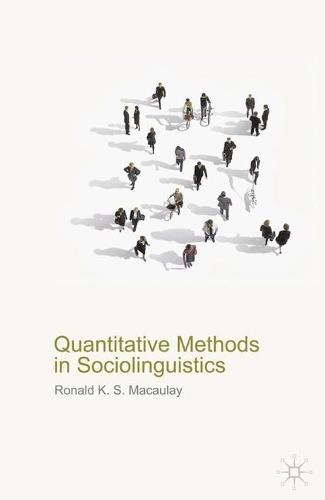Overview
This detailed textbook critically examines methods used in sociolinguistic studies, including the ways in which the categories of age, gender, ethnicity and social class have been employed to chart language variation. It discusses the nature of data and encourages students to examine evidence with a more critical eye.
Full Product Details
Author: Ronald Macaulay
Publisher: Bloomsbury Publishing PLC
Imprint: Red Globe Press
Dimensions:
Width: 13.80cm
, Height: 0.90cm
, Length: 21.60cm
Weight: 0.333kg
ISBN: 9780230579170
ISBN 10: 0230579175
Pages: 160
Publication Date: 14 August 2009
Audience:
College/higher education
,
Undergraduate
Format: Hardback
Publisher's Status: Out of Print
Availability: Out of stock

Reviews
I greatly welcome this book. On reading it I felt a need fulfilled. Just what were those early studies like? Is it really true that in their vast scope and care for detail they have never been matched? (the answer is yes, it is true). What cell sizes were used? What are the advantages, disadvantages and pitfalls with various ways of quantifying data across a sample? Do we need statistics, and if so what sort? I found answers to these questions here. Macaulay argues strongly for accountability to the research community by making raw data available - not always the case, but increasingly so, not least through the example of Macaulay's own practice. These issues are still very much with us today, and we would all do well to read this book for both inspiration and a fuller appreciation of the pioneering contributions of the early variationists - Professor Paul Kerswill, Lancaster University
I greatly welcome this book. On reading it I felt a need fulfilled. Just what were those early studies like? Is it really true that in their vast scope and care for detail they have never been matched? (the answer is yes, it is true). What cell sizes were used? What are the advantages, disadvantages and pitfalls with various ways of quantifying data across a sample? Do we need statistics, and if so what sort? I found answers to these questions here. Macaulay argues strongly for accountability to the research community by making raw data available - not always the case, but increasingly so, not least through the example of Macaulay's own practice. These issues are still very much with us today, and we would all do well to read this book for both inspiration and a fuller appreciation of the pioneering contributions of the early variationists - Professor Paul Kerswill, Lancaster University 'An excellent overview of the field of variationist sociolinguistics...presenting and explaining the main issues, concepts and studies the field has generated since its inception in the 1960s...this it does extraordinarily well.' - Sebastian M. Rasinger, Journal of Sociolinguistics 'Extremely valuable...will find its way onto many a reading list' - Sebastian M. Rasinger, Journal of Sociolinguistics
Author Information
RONALD MACAULAY K. S. is Emeritus Professor of Linguistics at Pitzer College, USA. He is the author of Language, Social Class and Education (1997), Locating Dialect in Discourse (1991), Standards and Variation in Urban Speech (1997), Talk that Counts: Age, Gender, and Social Class Differences in Discourse (2005), Extremely Common Eloquence (2005) and The Social Art (2006).




